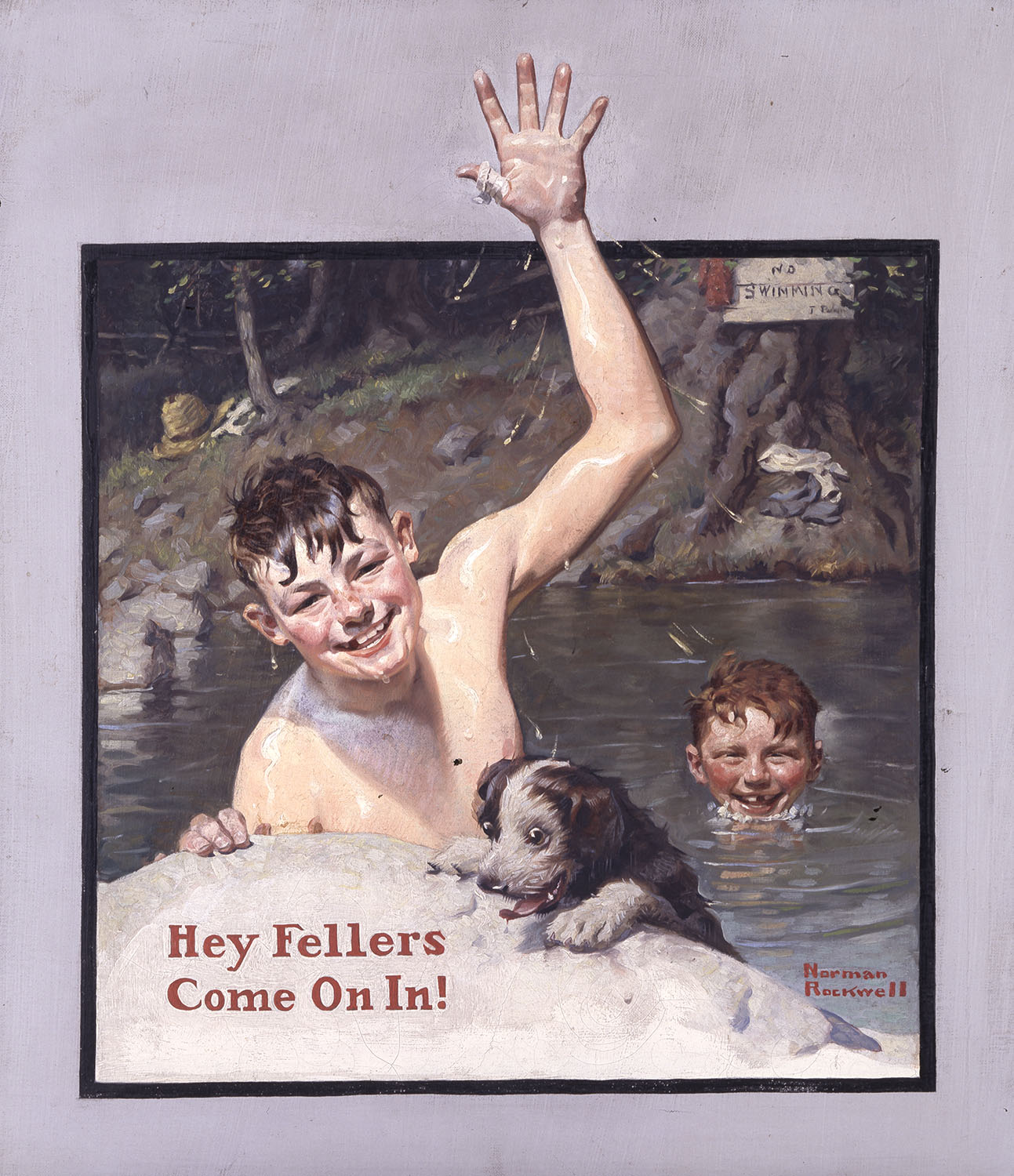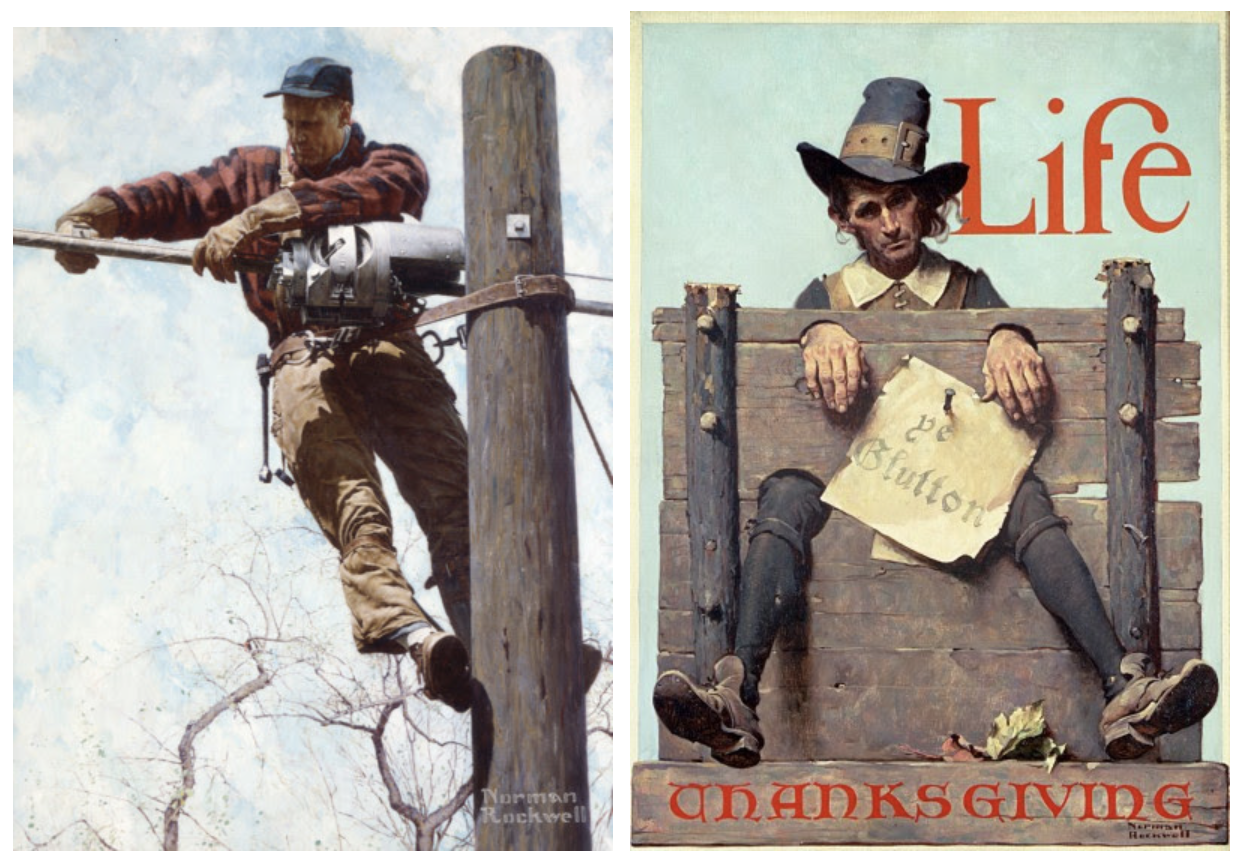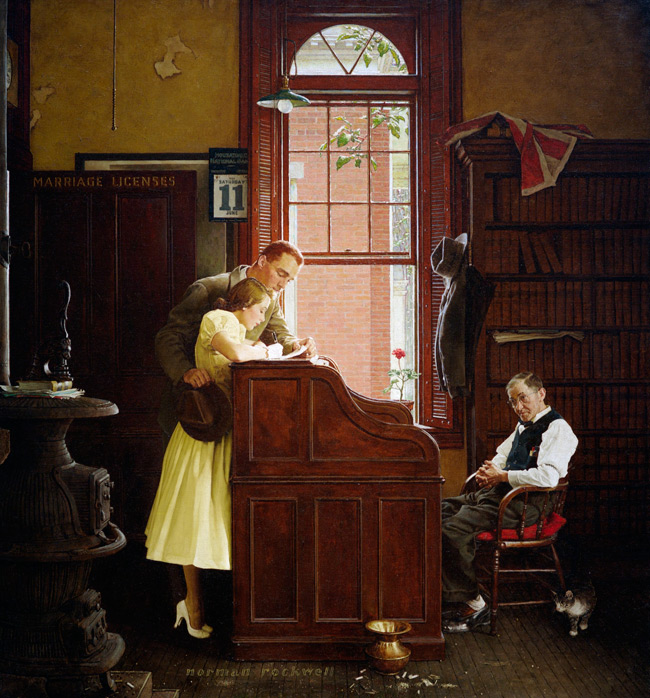FOR IMMEDIATE RELEASE
June 22, 2023
PRESS CONTACT:
Margit Hotchkiss
presscontact@nrm.org; 413.931.2240
Interviews and images available upon request
Beginning June 23, 2023
New Exhibition Reveals how mid-twentieth century American culture was powerfully shaped by commercial dictates of Rockwell imagery
Norman Rockwell: The Business of Illustrating the American Dream
opens June 23, 2023
STOCKBRIDGE, MA—Norman Rockwell Museum presents a new exhibition exploring the business and cultural context of Rockwell’s art. Norman Rockwell: The Business of Illustrating the American Dream examines how Rockwell navigated relationships with publishers, advertising clients, and other business entities to create work that shaped and reflected American culture and influenced notions of the American Dream. Based on extensive research in the Norman Rockwell Museum archives by guest curator Deborah Hoover, the exhibition shines new light on the interplay of artistry, advertising, consumerism, business relationships, and ambitious cultural, consumer and capitalist agendas that informed Rockwell’s work.
“I have long been passionate about the stories Norman Rockwell tells through his illustrations, filled with subtle details and larger meaning,” explained Hoover, an art and cultural historian scholar member of the Norman Rockwell Museum board of trustees. “Researching and designing this exhibition involved many hours in the expansive Rockwell Museum archives reading vast troves of Rockwell’s business correspondence and connecting the ideas and perspectives in these letters to developments in U.S. cultural history and the evolution of the American Dream.”
On view beginning on June 23, Norman Rockwell: The Business of Illustrating the American Dream features original paintings and drawings, as well as illuminating selections from Rockwell’s rarely seen business correspondence relating to his artistic consumer commissions.

“This exhibition places Rockwell’s stories and images into a historical context and elucidates his role as a revered influencer of his day. I hope visitors will be as excited as I am to examine Rockwell’s art of persuasion in this fresh light,” Hoover continued.
“Rockwell lovers and cultural history aficionados will find new ways of understanding the artist’s work and the context in which his images were shaped and disseminated,” notes Chief Curator Stephanie Haboush Plunkett.
“Cultural Historian Deb Hoover’s research offers fresh perspectives not only into Rockwell’s identity and success as a commercial artist depicting an aspirational vision of America, but offers insights into the powerful forces of mid-twentieth century publishing, advertising, and profit-driven corporate commercial culture that aimed to shape the American Dream, a vision targeted at largely white American consumers,” said NRM Director/CEO Laurie Norton Moffatt. “The exhibition also reveals the absence of those who were excluded from representation in pursuit of this dream in 20th century American culture.”
The exhibition focuses on three areas of Rockwell’s career: his relationships with magazine publishers and editors; his advertising clients; and his long association with The Famous Artist School, an international art correspondence course to train new generations of illustrators. Working within the often-strict parameters set by his clients, Rockwell created iconic and persuasive images that incorporated aspects of his own artistic vision and cultural perspectives. Rockwell’s business relationships at times, imposed constraints on his work, but also placed his talents and vision at the center of twentieth-century persuasive commercial image-making.
Exhibition Overview

Appearing to his public to be a self-directed artist, conjuring scenes of American life, during Rockwell’s long and celebrated career as an illustrator and chronicler of American life, Rockwell, like most illustrators, navigated a wide array of commercial business relationships. Expected to take direction from his corporate clients, he subtlety inserted his own perceptions of society, capturing temporal change through nuanced imagery and minute details. This exhibition will illuminate three such relationships to explore how client-to-artist negotiations and communications influenced the tenor and content of the images Rockwell created and the direction of his career.
For Rockwell’s magazine covers, and The Saturday Evening Post in particular, the artist was expected to adhere to strict parameters of image making designed to sell magazines to middle-class (majority white) consumers and businesspeople. In the view of the publisher, these audiences represented economically advantaged achievers seeking to realize the American Dream.
For his advertising clients, content and messaging were heavily influenced by trends in consumerism, connections of consumerism to democracy, powerful socio-economic and racial divides, and the economic science of advertising. Rockwell brought to these influences and constraints his own observations of societal trends and sensitivity to humanity.
Culminating his commercial success, Rockwell’s longtime association with Famous Artists Schools placed the artist and his exceptional talent at the center of an expansive international business, teaching art to those who had time to devote to the study of art in search of the economic awards portraying the American Dream. Famous Artists School provided Rockwell, at that stage in his multi-faceted career, with structure, benefits and consistency for his family at a time of personal challenge.
Rockwell was beholden to and served at the behest of his clients, yet he powerfully shaped a vision of America through his keen observation and affection for human interaction. Through the portrayals of his own perceptions into magazine and advertising images, he influenced the direction of American life. Late in life, Rockwell was able to loosen the constraints imposed by his commercial client relationships when working for Look magazine, he was finally able to depict the social injustices that haunted him throughout his life and career.

About Deborah Hoover

Deborah Hoover is a scholar of art history and cultural history who has worked in the field of philanthropy as a foundation president for the last two decades. She holds a BA in art history from Williams College; an MA with a concentration in Italian Renaissance art from the University of Chicago
; a JD from George Washington University Law School, where she also took classes in museum studies; and, most recently, an MA in cultural history from Kent State University. This exhibition, Norman Rockwell: The Business of Illustrating the American Dream, evolved from the thesis she developed while at Kent State working with graduate advisor Dr. Kenneth Bindas. Ms. Hoover also holds an Honorary Doctor of Humane Letters from Baldwin Wallace University. She served on the New Hampshire State Council on the Arts in the 1990s, and is a collector of American 19th- and 20th-century prints. Passionate about the art and visual storytelling of Norman Rockwell, Ms. Hoover is a board member of the Norman Rockwell Museum, and previously served on its National Council.
About Norman Rockwell Museum
The Norman Rockwell Museum illuminates the power of American illustration art to reflect and shape society, and advances the enduring values of kindness, respect, and social equity portrayed by Norman Rockwell. A comprehensive resource relating to Norman Rockwell and the art of illustration, American visual culture, and the role of published imagery in society, the Museum holds the world’s largest and most significant collection of art and archival materials relating to Rockwell’s life and work, while also preserving, interpreting, and exhibiting a growing collection of art by other American illustrators throughout history. The Museum engages diverse audiences through onsite and traveling exhibitions, as well as publications, arts and humanities programs, including the Rockwell Center for American Visual Studies, and comprehensive online resources.
NRM is open year-round, six days a week; closed Wednesdays. Admission is charged, Free for Kids & Teens. For details, visit the Museum online at www.NRM.org.
Image credits
Norman Rockwell (1894-1978) Going and Coming, 1947. Painting for The Saturday Evening Post cover, August 30, 1947. Oil on canvas: upper canvas, 16 x 31.5 inches; lower canvas, 16 x 31.5 inches. Norman Rockwell Museum Collection, NRACT.1973.9. ©1947 SEPS: Licensed by Curtis Publishing, Indianapolis, IN.
Norman Rockwell (1894-1978) Hey Fellers, Come On In! 1920. Cover illustration for The Country Gentleman, June 19, 1920. Oil on canvas. Norman Rockwell Museum Collection.
Norman Rockwell (1894-1978) The Lineman, 1948. Advertisement illustration for Bell Telephone Company, 1949. Oil on canvas. Norman Rockwell Museum Collection, Norman Rockwell Art Collection Trust, NRM.2007.11.
Norman Rockwell (1894-1978) Thanksgiving Ye Glutton, 1923. Cover illustration for Life, November 22, 1923. Oil on canvas. Norman Rockwell Museum Collection NRM.1986.03.
Norman Rockwell (1894-1978) The Marriage License, 1955. Cover illustration for The Saturday Evening Post, June 11, 1955. Oil on canvas. Norman Rockwell Museum Collection, Norman Rockwell Art Collection Trust, NRACT.1973.014. ©1955 SEPS: Licensed by Curtis Publishing, Indianapolis, IN.

